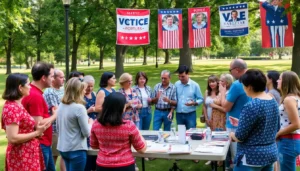In a world where political giants often overshadow the little guy, grassroots campaigning emerges as the underdog hero. Picture this: a group of passionate individuals banding together, armed with nothing but enthusiasm, creativity, and maybe a few homemade signs. They’re not just raising awareness; they’re shaking things up, proving that change often starts at the local level, one enthusiastic conversation at a time.
Table of Contents
ToggleUnderstanding Grassroots Campaigning
Grassroots campaigning serves as a vital mechanism for social change and community empowerment. This approach often relies on local volunteers to mobilize support and create awareness.
Definition and Principles
Grassroots campaigning centers on community involvement and local advocacy. Individuals come together to address pressing issues that affect their neighborhoods. This method emphasizes organization, collaboration, and direct engagement. Effective grassroots campaigns utilize various communication channels, including social media, community meetings, and door-to-door outreach. Each principle involves fostering relationships and empowering citizens to drive change from the ground up.
Importance in Modern Politics
Modern politics increasingly values grassroots campaigns due to their authenticity. These initiatives often bridge the gap between elected officials and constituents. In addition, grassroots movements bring localized issues to the forefront, influencing broader political agendas. Examples of successful grassroots efforts demonstrate the power of collective action. Engaging communities fosters accountability and transparency in governance. Ultimately, grassroots campaigning encourages diverse voices to shape political discourse, leading to more representative outcomes.
Key Elements of Successful Grassroots Campaigns

Effective grassroots campaigns rely on a few key elements that drive success. These aspects ensure community involvement and foster impactful change.
Building a Strong Community
A vibrant community forms the backbone of any grassroots campaign. Local volunteers unite around shared causes, creating a sense of solidarity. Involvement often leads to increased trust, as neighbors collaborate on initiatives that resonate personally. Engaging individuals from diverse backgrounds enhances the campaign’s reach and represents various perspectives. Hosting community events cultivates connections, reinforcing relationships vital for mobilization. Access to local organizations can amplify outreach efforts, providing essential resources and insights. Ultimately, strong community ties empower individuals to advocate for issues affecting their lives.
Effective Communication Strategies
Clear and compelling communication is crucial for grassroots success. Messaging should be tailored to the target audience, resonating with their values and concerns. Utilizing various channels, such as social media, email, and local publications, maximizes outreach potential. Consistent updates keep supporters informed and engaged, fostering a sense of belonging. Storytelling captures attention, allowing narratives to illustrate the campaign’s impact effectively. Personal interactions, like door-to-door conversations, create lasting relationships and strengthen commitment. Leveraging testimonials from community members enhances credibility, encouraging wider participation and advocacy.
Challenges in Grassroots Campaigning
Grassroots campaigning faces several notable challenges that can hinder effectiveness.
Mobilization and Engagement
Mobilizing volunteers often requires significant effort and strategy. Many grassroots campaigns struggle to inspire and maintain engagement among community members. Ensuring volunteers remain committed is essential for sustained impact. Varying levels of interest and availability among individuals can create inconsistencies in participation. Utilizing social media and community events can help increase outreach, but the challenge lies in transforming passive support into active involvement. Building a strong sense of community is vital, as relationships drive deeper engagement and motivation over time. Campaign organizers benefit from clear communication, aligning volunteers with issues that resonate personally with them.
Resource Limitations
Resource limitations often constrain grassroots efforts. Many campaigns operate on tight budgets, restricting their ability to produce materials or hire staff. Obtaining funding can prove difficult, especially in areas where financial support for local initiatives is scarce. Volunteers frequently juggle multiple responsibilities, limiting their time commitment to the campaign. Effective grassroots campaigns must therefore prioritize creative solutions to maximize impact with available resources. Networking with local businesses or organizations can provide additional support, enhancing both reach and resources. Focusing on collaboration allows teams to share tools and strategies, amplifying their effectiveness despite resource constraints.
Case Studies of Successful Grassroots Campaigns
Grassroots campaigning has demonstrated remarkable successes throughout history and in recent times. Various case studies illustrate the dynamics involved in building impactful movements.
Historic Examples
One significant historic example comes from the Civil Rights Movement. Activities led by community organizers aimed to dismantle systemic racism. Events such as the Montgomery Bus Boycott showcased the power of collective action. Local leaders, including Rosa Parks and Martin Luther King Jr., mobilized supporters effectively. Their efforts highlighted the importance of community solidarity and local engagement.
Another notable instance occurred in the suffragette movement. Women united across the United States to advocate for voting rights. Through protests, rallies, and lobbying, they raised awareness about gender inequality. Campaigns played a critical role in leading to the passing of the 19th Amendment in 1920. This example underscores grassroots campaigning’s ability to influence substantial societal changes.
Recent Campaigns
The recent Fight for $15 campaign illustrates contemporary grassroots efforts. Workers across various sectors demanded higher wages and improved labor conditions. Organizers utilized social media to amplify their message and connect supporters. Rallies and strikes occurred in cities nationwide, generating widespread attention. Their persistence led to the adoption of minimum wage increases in several states.
Another example is the Sunrise Movement, focused on climate change. Young activists mobilized to advocate for the Green New Deal. By leveraging digital platforms and community events, they engaged a diverse demographic. The movement’s success in influencing political discourse reflects the power of grassroots strategies. These campaigns emphasize the importance of local voices in shaping policy discussions.
Grassroots campaigning stands as a testament to the power of community-driven efforts in shaping the political landscape. By engaging local volunteers and fostering authentic connections, these campaigns not only address immediate concerns but also empower individuals to advocate for lasting change. The collective action seen in successful grassroots initiatives illustrates how local voices can influence broader political agendas and promote accountability.
Despite the challenges faced, the resilience and creativity of grassroots movements continue to inspire, demonstrating that meaningful change often starts at the community level. As individuals unite around shared causes, they pave the way for a more representative and engaged political discourse, ensuring that diverse perspectives are heard and valued in the ongoing pursuit of social justice.





